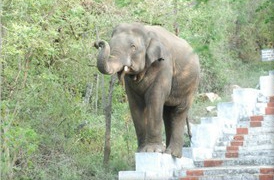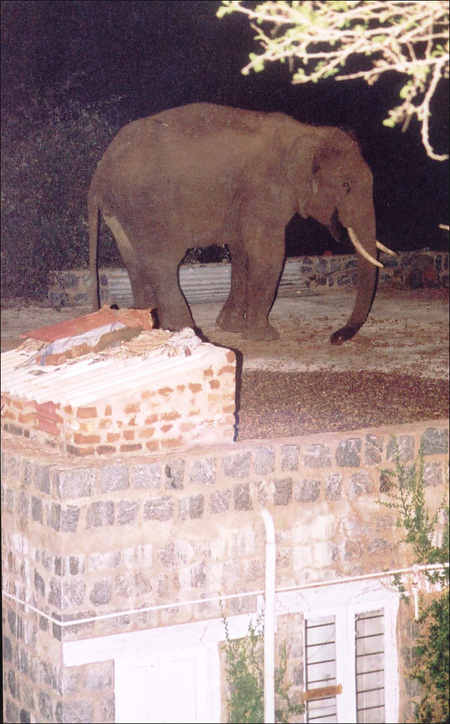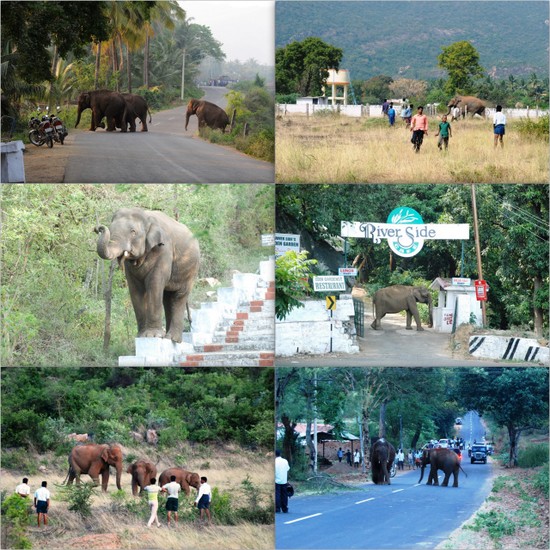People’s perception on elephant depredation and conservation
This article by WTI’s K Ramkumar was first published in THE FLAGPOST magazine’s May 2014 issue.
“Elephant on house visit scares Kovai” screamed the newspaper headlines on 18th March 2013. A wild tusker entered a thickly populated residential area and caused havoc. Ramanathan and his family trembled in fear as another elephant broke open the iron gate of their house and entered the premises at Press Enclave in Kovaipudur at the crack of dawn.
While conflicts in rural areas were all too common, similar situations have become all too visible even in Indian cities located close to elephant range forests since 2000. Earlier elephants used to visit only forest fringe villages, attracted by standing crops. These days however, elephants are coming frequently into the human habitation and crop fields located even more than five kilometers from forest boundary. It had been recorded that a herd of elephants had even ‘strayed’ 25 km away from forests in Coimbatore, Tamil Nadu in 2006. This was believed to be a one-off incident wherein the elephants had lost their way. But then, similar instances of ‘long-distance straying’ started occurring in other parts of Tamil Nadu and Karnataka forests repeatedly, indicating that there was more than meets the eye.
When elephants leave their natural habitat, speculations on the causes include increasing elephant numbers, inadequate food resources in forests and blockage of corridor etc. Observations reveal that elephants visit crop fields during night hours (after 11 PM) and stay up till early morning 5 PM and then return to the forest again. If the elephants failed to go back before sun rise due to some reasons, they will be virtually trapped outside forest areas for the entire day, surrounded by human crowd. During this time, elephants sometimes take refuge in some bushes available nearby and try to go back to forest late evening or midnight. At other times, they were driven by villagers from all directions, causing them to move further into human settlements, making it difficult for them to return to the forests. This is one of the major reasons for elephants straying for long distance in to the private lands. Such incidences are happening occasionally. Apart from that, it is not implausible that the elephants’ behavior itself has changed over the period due to various biotic factors and the pachyderms have habituated well with human environment.
Over the past few decades many developmental and destructive activities of humans have severely affected the forests. The Asian elephant are one of the main animals to suffer the consequences of developmental activities. A big question arises that how best elephant and human beings can live in a human induced environment. Attitudes of local people to wildlife and particularly to large animals are an important element for conservation.
A recent survey by wildlife biologists Mr. Kalyanasundaram Ramkumar, Dr. Balasundaram Ramakrishnan and team on people’s perception on elephant depredation and conservation around Coimbatore forests has provided very interesting results. About 65% of people had experienced crop damage by elephants at least once in their life time. A large number of people believed that less availability of elephant food species in the forests were highly responsible for elephant depredation. Fifteen years back, Dr. Cheryl D.Nath, Wildlife biologist received the same opinion from people of Kodagu district of Karnataka. It shows people’s attitude on causes of conflict has not changed much over this period.
The biologists Ramkumar and Ramakrishnan also surprisingly found that less than 2% of the respondents felt that location of crops closer to forest foothills was responsible for human – elephant conflict (HEC). A large number believed that less availability of elephant food species in the forests were highly responsible for HEC. None of the respondents believed that constructions in elephant corridor or close to the forest foothills were responsible for increased HEC, despite numerous news reports indicating the same.
Respondents’ opinion on methods to reduce HEC revealed preference of electric fence and elephant proof trench (EPT). Interestingly habitat improvement also received remarkable support from people. Capture of elephants was supported by less than 8% of respondents (contrary to 49% of respondents from Kodagu district of Karnataka supporting this case in 1998). None of the respondents considered culling of elephants and elephant scaring squad as the suitable method to reduce HEC.
Surprisingly, of the respondents, only 1% supported compensation for crop loss caused by elephants. About 41.5 % of respondents have opined that combination of various methods were considered as the most effective method to reduce HEC. Even though there was a mixed opinion from respondents, one thing was very clear that people showing more interest towards prevention of HEC rather than compensation for the loss of crop, asset and human life, and they still consider as a common heritage than property of a government department.
Respondents’ opinion towards worth for elephant conservation (87%) revealed positive attitude of stake holders. Most of them believed the elephants have right to live (80%) and the elephant is considered as Lord Ganesh’s avatar. These kind of beliefs have helped conservation in India and will continue to do so.
When asked whether conservation of elephants in the wild is important for both economic and non-economic reason, surprisingly 79% agreed. About 92% of people expected that Government and international organisation should pay more attention to the elephant conservation and the mitigation of HEC in the country. When asked opinion on whether animal have a right to exist and people who poach them should be punished, 96% of respondents agreed. The respondents were also asked that whether it is very important to have places where native wildlife and plants are preserved; about 74% agreed.
Generally, past negative experiences and fear of the animal is likely to create a more negative attitude among the people. Even though HEC is in increasing trend over the years near forest areas, still most of the people showed positive attitude towards elephants conservation. This is a good sign, and the authorities would do well to take these learnings into account and take these communities into confidence while preparing collaborative conservation plans to ensure long-term survival of Asian elephants in the country.











